

"First there was a struggle at the barricade of shields; then the barricade down, there was a bitter and protracted fight, hand to hand... for the Persians would grab hold of the Spartan spears and break them; in courage and strength they were as good as their adversaries, but they were deficient in armor, untrained and greatly inferior in skill. Sometimes singly, sometimes in groups of ten—perhaps fewer, perhaps more, they fell upon the Spartan line and were cut down." Herodotus
The Persian Immortal
Lasset 54mm white metal miniature
The Persians under the Achaemenid king Darius I tried to subdue Greece with two major invasions. The first invasion was defeated by Athens at Marathon in 490 bc. This was the first time the Greeks had faced the terrible Persian robes, conquerors of the east, and the largest world empire to that date. A second invasion in 480 bc was ordered by Darius' son, Xerxes. This was a massive undertaking that dwarfed the previous naval excursion. Large numbers of troops were led into Greece, supported by a huge fleet. The Great King accompanied the army, and his Immortal guard followed with him. The Immortals were defeated by the Greeks at Thermopylae in a frontal charge, but the Immortals gained revenge and surrounded the Greek rear guard led by Leonidas the Spartan King and his retinue. No doubt the Persians were perplexed by the stubborn Greek resistance, but still they won. I reckon they would not have known the Greeks won a "moral victory", as the Greeks wrote the history.
The Immortals marched to Athens which was abandoned and except for the Acropolis, undefended. A group of Athenians had barricaded the Acropolis but the Immortals and the Persian forces overwhlemed them and sacked and burned the Acropolis. A year later detachment of Immortals fought the Greeks at Plataea. The Spartans drove through their spara walls, and routed them. The Persian army was hounded in retreat back to Asia. One group of Persians which most likely included the remnants of the Immortals, retreated in good order to Byzantium, then back to Asia.
"A body of picked Persians under the leadership of Hydarnes, the son Hydarnes. This corps was known as the Immortals, because it was invariably kept up to strength; if a man was killed or fell sick, the vacancy he left was at once filled, so that the total strength of the corps was never less -and never more- than ten thousand.


Persian Guards from Susa and Persepolis.
Of course the most "Immortal" aspect of the Persian Guards is the idea that they are one of the first standing regiments in history. They were reportedly kept up to a strength of 10,000 men (the Greeks use the word myriad to describe them). When a guardsmen died or retired the unit was kept up to strength, hence the idea that the regiment was immortal. The Immortals were lavishly rewarded with gifts. Each soldier had a silver pomegranate as a counterbalance to his spear. Officers and an elite 1000 reputedly had golden pomegranates. The Great King would give out golden lotus statues for merit, probably the first known military decoration. After Persia was defeated in the west, the empire slipped into some disorder. Constant civil wars and struggles for power diminished Achaemenid power. By the time of Alexander the Great's invasion in 334 bc, the Persian foot guards were reduced to a unit of 1000 men, called melophoroi at that time as they now had golden apples as spear butts, and used Greek style round shields.
The figure represents an Immortal as he would appear on guard duty at Thermopylae. These robes are depicted on reliefs and on some wonderful glazed brick friezes. The model is a 54mm "Lasset" figure. The Lasset miniature range was popular in the 1970's. They released a large selection of ancient models, and they soon became my favorites, even though they were expensive back in the day- $6.50 each!!. (Of course the good news is that I could paint one and sell it for 25$ woohoo!!)
This model won a first place in miniature competition back in the day- I think that was mostly because it a very nice figure to begin with. I only followed the patterns on the glazed brick art from the Louvre, its' practically color by numbers. I did add the bow, which was built out of various wire bits wrapped around a paper clip. Herodotus tells us that Xerxes sat on a throne and watched the battle of Thermopylae from the heights in horror as his Immortals were massacred by the Spartans. I kind of thought of that scene with this model.... kind of like this fellow is on gurad duty surveying the carnage after the battle. He has that 1000 yard stare....
JJ
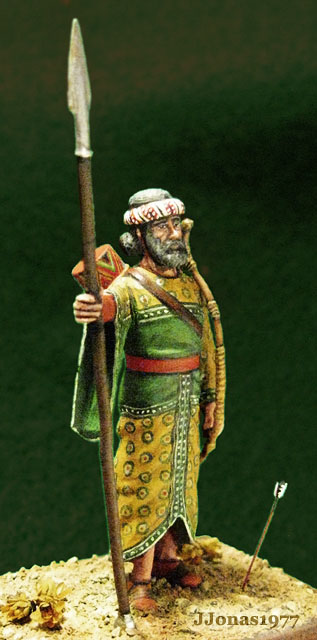

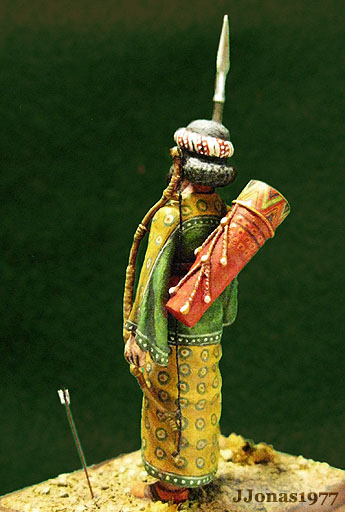
Strange how much the figure ended looking like Saddam Hussein?

"The dress of these troops consisted of the tiara, or soft felt cap, embroidered tunic with sleeves, a coat of mail looking like the scales of a fish, and trousers; for arms they carried light wicker shields, quivers slung below them, short spears, powerful bows with cane arrows, and short swords swinging from belts beside the right thigh."
The Immortals wore less elaborate clothing for combat. This "Median" outfit is more appropriate for fighting and marching. The wicker shield called gerrha by Herodotus is the subject of much controversy. Nowadays it is much more fashionable to show Persians using the large rectangular 'spara' shields, rather than the archaic dipylon shield.
Here's a good link for Achaemenid shields and stuff:
http://members.ozemail.com.au/~ancientpersia/shields.html
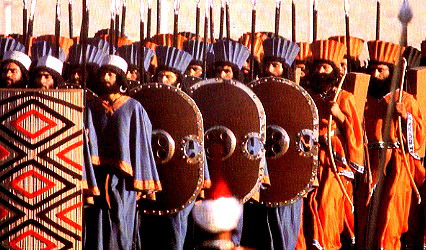
The Shah of Iran delighted in massive re-enactments of ancient Persian glory.
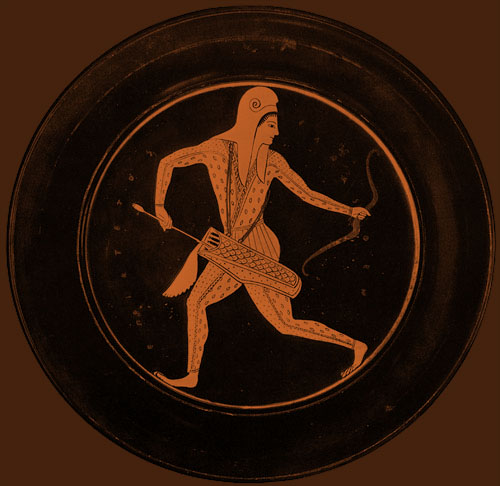
A Persian
soldier uses his preferred weapon, a composite bow.
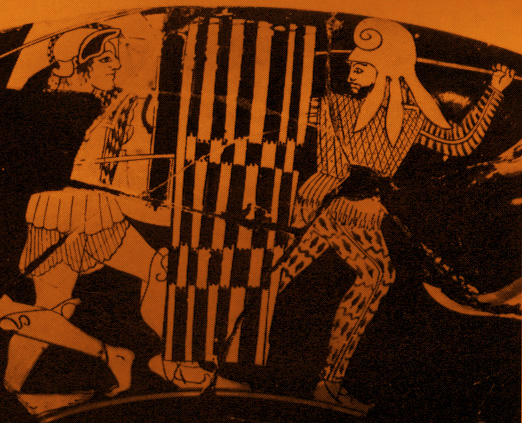
In hand to
hand the front ranks were protected by large shields called spara set up as a wall.
The Greeks hacked their way through these "Spara" walls, and the unshielded
archers were no match for them in hand to hand combat.

After Persia was defeated militarily by the Greeks, this became their preferred weapon.... the Daric... known to the Greeks as "Persian Archers". The Persians used their wealth to bribe and divide the Greeks into factions which constantly were at war with each other, which kept them weak.
THE PERSIANS
by
Aeschylus
O thou afflicted monarch, once the lord
Of marshall'd armies, of the lustre beam'd
From glory's ray o'er Persia, of her sons
The pride, the grace, whom ruin now hath sunk
In blood! The unpeopled land laments her youth
By Xerxes led to slaughter, till the realms
Of death are gorged with Persians; for the flower
Of all the realm, thousands, whose dreadful bows
With arrowy shower annoy'd the foe, are fall'n.
Your fall, heroic youths, distracts my soul.
And Asia sinking on her knee, O king,
Oppress'd, with griefs oppress'd, bends to the earth.
